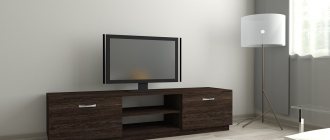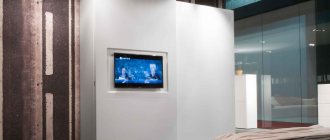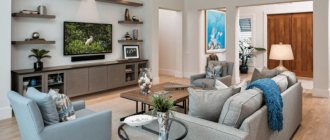When choosing a TV, many buyers think that the larger its size, the better and clearer the broadcast image will be. However, a completely different characteristic is responsible for quality. At the same time, many people forget that the wrong device can look awkward in the room and also cause some discomfort when viewing. For example, a large TV will look extremely bad in a small room. Therefore, when purchasing, you must first take into account the area of the room in which the TV receiver will be placed.
What diagonals and resolutions do TVs have?
The first 2 digits in the TV model marking indicate the display diagonal. This parameter is equivalent to the distance between opposite corners of the screen. Absolutely all manufacturers use a generally accepted unit of measurement. Therefore, TV screen size is always measured in inches. To convert inches to centimeters, use the factor 2.54. For example, the diagonal of a 32-inch model is 81.3 centimeters.
What diagonal for a TV can be considered optimal? Large displays advantageously provide maximum viewing angles. However, buying such a TV is not always a rational decision. Firstly, the screen size directly affects the cost of the equipment. Therefore, for a model with a maximum diagonal you will have to pay an impressive amount. Secondly, it is the area of the room that determines how many inches the TV diagonal should be.
Remember that TV size and screen size are fundamentally different concepts. The first parameter is slightly larger than the second. Which is not surprising, because the width of the frame is also taken into account. Manufacturers are trying to produce devices with the thinnest frames possible. This is a kind of trend in technology design. Therefore, the difference between the size of the TV and the screen is gradually decreasing.
There is also such a thing as aspect ratio. Modern TVs are sold with a 16:9 aspect ratio. Media content and television broadcasting also correspond to this format. How to choose a TV? Many users encounter certain difficulties. Because it is necessary to take into account not only the diagonal, but also the screen resolution. The quality of the image and ease of viewing depend on the resolution.
Perhaps the most common and in demand are models with Full HD, HD Ready resolution. Full HD resolution is 1920x1080 pixels, and HD Ready is 1366x768 pixels. The higher the pixel density, the higher the quality of the broadcast image. If the image is formed from a large number of points, then viewing will be comfortable even from a close distance. The picture will not blur.
For example, if the screen diagonal is 32 inches and the resolution is 625 pixels, then the viewing point should be located two and a half meters from the TV. When the resolution is 720 pixels with an identical diagonal, you can watch even while being two meters from the TV.
Not every buyer realizes the importance of screen resolution. Not to mention calculating the correct distance from the viewing point to the TV. The calculation is carried out in accordance with a special table (will be presented at the end of the article). The permit also directly affects the cost of the equipment.
It is unusually common to find models with a large diagonal and 720p resolution in electronics supermarkets. Problems during viewing may arise if the viewer is closer than three meters from the screen. The image quality drops noticeably. It is not always possible to allocate a sufficient amount of space. Therefore, be sure to consider the size of the room when purchasing.
Models with a diagonal of 17 inches and a resolution of 1080 pixels can also hardly be called a good solution. The picture quality will be no different from 480 pixels.
Diagonal
Sizes range from small (19 inches) to large (180 inches). The latter are used as a home theater. To calculate the ideal monitor format, you need to divide the distance between the TV and the viewer by 4.
For example, a 50-inch diagonal is suitable for a room where the sofa is located 3 meters from the TV. A correctly selected model will ensure comfortable and safe viewing of your favorite TV shows and movies.
How are TV diagonal and resolution related?
The optimal distance for placing a TV from your favorite sofa depends not only on the diagonal size, but also on the resolution of the matrix. Screen resolution directly affects the quality of the broadcast image. As a rule, TVs use matrices with the following resolution:
- HD Ready - 1366x768.
- Full HD - 1920x1080.
- Ultra HD - 3840x2160.
These numbers indicate the number of pixels. There is also a 4K resolution, which is several times higher than Full HD and the number of pixels is about 8 million. Thus, the greater the number of pixels, the clearer the transmitted image will be. In this case, the optimal distance will be smaller. That is, TV receivers with a higher screen resolution can be viewed from a shorter distance.
For example, a TV with a diagonal of 32 inches and a resolution of 625 pixels must be viewed from a distance of about 2.5 meters, and if the resolution is already 720, then one and a half meters will be enough. It is worth adding that high resolution is realized on devices with a diagonal of 40 inches or more. And the smaller the diagonal, the less noticeable the difference in resolution.
When buying a TV, you should focus on several parameters: room size, screen resolution, availability of functions. After all, each of the indicators affects the cost and ease of viewing.
How to choose a diagonal depending on the distance
Many owners of modern TVs do not know what distance to the TV is considered the safest and most convenient for viewing. In this case, it is necessary to take into account such a factor as screen resolution.
From what distance can you watch TV with Full HD resolution?
First of all, the distance between the television receiver and the viewing location is determined. After this, in accordance with the table above, you can select the most suitable diagonal.
Distance has a big impact on the perception of resolution. As you can see in the figure, when you get very close to the screen, the pixels will be clearly visible. With the standard 1920x1080, when the eye covers a sector of 90 degrees, the number of pixels will be 21 per 1 degree. As the distance increases, the angle will decrease and the pixel density will increase. Accordingly, the image quality will increase.
This effect is called angular resolution. The greater the distance to the screen, the higher its performance, the brighter and clearer the picture will be. There is a THX standard that recommends a viewing angle of 40°. The SMPTE standard is even smaller - only 30 degrees.
You should choose the safest distance with obligatory reference to the diagonal. For example, at a distance of 1.5 m the diagonal will be 32 inches. All other indicators increase proportionally: 1.6 – 40, 1.7 – 42, 1.9 – 47, 2 – 50, etc.
From what distance can you watch TV with 4k Ultra HD resolution?
The Ultra HD standard implies a high resolution of 4k, which corresponds to 4000 pixels. The best quality image is obtained with a length to width ratio of 16:9. For normal viewing, additional equipment and special high-quality content are required.
Despite the high cost, devices with such matrices confidently find their users. Experienced lovers of the latest technologies have long formed their opinion about these TVs:
- It is believed that a standard scan of 3840x2160 makes it possible to view the latest level standards at 4096x2160. Sharpness, clarity, contrast and color rendition are perfectly maintained.
- The high cost of TVs is successfully compensated by the possibility of viewing at any distance. When choosing sizes, only the features of the room itself are taken into account. However, other users believe that the proportionality of the diagonal and distance must be taken into account.
- Very often the choice is difficult precisely because of the high resolution. It is difficult to combine all the parameters to get the most suitable option. Special tables with which you can make the most accurate calculations of indicators.
3D TVs
In modern conditions, 3D films can be watched not only in cinemas, but also on home equipment. We are talking about the latest TVs that support this function. Purchase a disc with stereo effects and you can start watching.
To avoid difficulties using this technique, it is recommended to follow several rules:
- Many people don't know how to determine whether a disc is compatible with their existing TV. The most popular and high-quality format is Bly-ray. Such drives are not cheap, but they have virtually no compatibility problems.
- New TVs, as a rule, recognize the 3D format themselves and start viewing automatically. Only a small number of models require manual adjustments. For this purpose, there is a special button on the control panel.
- To view, you can use a special player connected via an HDMI connector. The film image is downloaded and recorded on external media. All that remains is to connect it to the TV and start watching.
- The TV can be connected to a computer with a powerful video card that supports 3D. The minimum amount of RAM is 2 GB. To launch the downloaded movie, use a player suitable for this purpose. In this case, the TV must be in 3D mode. The viewing itself is carried out using special stereo glasses.
What does the diagonal of the TV screen affect?
The diagonal of a TV screen is an important characteristic that largely determines the clarity and quality of the displayed picture. However, to select and purchase the optimal TV model, it is not enough to know the required diagonal of the device. The following factors are no less important.
Screen diagonal and viewing distance
During the old CRT television receivers, there was a formula according to which the ideal distance from the monitor to the viewer was considered to be a distance equal to 4-5 screen diagonals. The advent of innovative technologies has made it possible to significantly reduce the harm caused by TV to human eyes, thanks to which the choice of distance is made primarily based on the convenience of viewing the video.
Viewing comfort depends on the pixel structure of the picture on the screen. In this case, the optimal distance for watching TV is considered to be the distance at which the viewer cannot see the pixels (colored dots) on the screen. It is noteworthy that if we are talking about large-sized television panels, then when viewing them at a short distance, the illusion of being in a cinema is created. In such conditions, peripheral vision is activated and a person gets the opportunity to immerse himself as fully as possible in the plot of a program or film.
However, if you watch educational programs or news programs on large diagonal TVs, you will have to sit as far away as possible in order not to lose sight of all the elements of the screen - titles, ticker, timer in sports matches, etc. Ideally, the distance from the monitor and its diagonal should be selected in such a way that when viewing, viewers do not have to constantly turn their heads and change body position in order to follow what is happening.
Important nuances
When searching, evaluate some of the TV's properties.
- To mount the device on the wall, the buyer chooses a thin option that would blend in with the wall as much as possible. In the case of drywall that cannot support the weight of the screen, it is installed on furniture using a stand. When purchasing, it is worth considering the size of the stand and the cabinet or cabinet.
- Energy consumption increases according to the size of the screen diagonal. LED TVs require 40-300 Watts per hour. OLED is more economical in this regard. To reduce this indicator, the energy saving function and intelligent backlight control are used.
- Theoretically, a TV can last 20-30 years. The manufacturer guarantees high-quality work for 50,000-100,000 hours. After this time, the picture may not be displayed as brightly.
- The decisive factor in the purchase is the availability of ports for connecting external media: USB (flash card, smartphone, camera, etc.), HDMI (connecting a computer, gaming equipment), LAN (port for an Internet cable), AV (connecting audio equipment ).
- Brand. The cost of a product directly depends on its manufacturer. According to the rating, the top manufacturers are headed by: Sony, LG, Samsung, Panasonic, Philips. Companies produce products of budget, middle and premium classes. They maintain their position thanks to quality and the rapid provision of new technologies to televisions.
Many houses and apartments have not one, but several televisions. The room in which it is located affects the characteristics.
Features of choice
Calculating the diagonal of a TV is extremely important, but this process may be subject to certain changes according to the type of screen. This parameter directly affects the quality of the broadcast image. CRT models have long been considered a relic of the past. Therefore, we will concentrate on the most common options today.
LED TV is a liquid crystal matrix. The lighting system consists of miniature LEDs. This technology is considered extremely effective. It provides the deepest color possible. LED panels guarantee high-quality color reproduction in a wide range, and also significantly expand viewing angles. You can watch this TV anywhere in the room within a range of up to 180 degrees from the display side.
OLED TVs are distinguished by the fact that each pixel is individually illuminated. The technology allows you to achieve high-quality contrast images with color rendering in the range of 2-5 nanometers. High image refresh rates improve LED technology by approximately 200 times. Even when showing dynamic scenes, there is no blurring effect.
Consider the distance when choosing the TV diagonal. However, LED and OLED technologies are 100% harmless to the visual system. Therefore, the distance from the screen to the viewing point is not of fundamental importance.
How to choose a TV according to the size and shape of the screen? The diagonal will depend on the room in which the device is located. As for the form, there are certain nuances. Today, stores offer a wide range of both curved and traditional flat models. Each option has its own specific advantages and disadvantages. However, curved TVs are much more expensive.
Support for HDR technology is another point that should be taken into account when choosing technology. This standard has higher brightness. On the screen, the viewer will see the most natural image possible. Therefore, if possible, then buy a model that supports this technology.
Now let's talk about how to choose a TV size. The calculation of the optimal size is carried out in accordance with a special formula. So that all users understand how to get the optimal value, let's look at a few illustrative examples.
Let's imagine that the client's choice fell on a Full HD TV. The approximate distance between the viewing point and the screen is 2 meters. To get the optimal diagonal, you need to divide the distance of 200 cm by 1.56, and then by 2.54 (to convert to inches). In the end we got 50.4 inches. It is this diagonal that will be considered optimal for a given resolution and distance.
Now let's look at another example. The user buys a model with 4K resolution. This is premium-segment equipment with impressive functionality and elegant design. The distance from the screen to the viewing point will be one and a half meters. Now, using a similar principle, we will calculate the optimal screen diagonal. Divide 100 centimeters by 0.7, and then by 2.54. We get a result of 56.2 inches. This means that the diagonal should vary in the range of 55-60 inches.
Conclusion
To summarize, we note that if you do not know which TV to choose based on screen size, you need to take into account the previously described factors. Here you need to take into account: the size of the room, the placement of the device, the number of inches, resolution and your budget. Therefore, how many inches are suitable in a given situation is determined depending on these indicators, which are individual. And of course, we should not forget about the budget. Remember that “more is better” not in all cases.
Features of the room
There are three defining criteria according to which a TV is selected: diagonal, resolution and room size, namely the distance from the screen to the viewing point. TV lines from modern manufacturers consist of a large number of models with different screen sizes. The diagonal varies from 19 to 58 inches. Of course, there are larger TVs, but let's focus on the most popular models.
There may be some difficulties in calculating the optimal size in inches. To simplify the process, convert the value to centimeters. As a result, we will get a range of 48-147 centimeters. The screen dimensions will significantly affect the cost of the equipment. The larger the display, the higher the price.
Traditionally, users with significant budgets rely on models with the largest screen diagonal. However, such a decision cannot be called rational. It is necessary to consider the size of the room in which the TV will be located. A large LCD TV will not fit into a small room. At a short distance, the viewer’s eyes simply will not cover the screen.
When you are in an electronics supermarket, it is extremely difficult to objectively assess which diagonal is suitable for your room. That is why it is more advisable to calculate the diagonal in advance. We have already discussed how to determine the most suitable device. Calculations are carried out using a special formula.
You can always try to visually place the TV in your room to roughly assess how harmoniously it will fit into it. Choose several models with different screen diagonals. When you get home, make notes on the wall near which the device will be placed. Take a seat at your viewing point and visually assess which diagonal suits you best.
Using the recommendations proposed above, you can choose the diagonal as efficiently as possible, taking into account the square footage of the room. Screen size has its own specific characteristics. Therefore, you cannot ignore the layout of the room in which the TV will be installed. For example, if you are looking for a suitable model for the kitchen, then think in advance about where exactly it is best to hang the TV. The device must not interfere with cooking.
Each user will be able to find on the Internet special criteria in accordance with which the process of choosing a new TV should be carried out. However, these rules do not always allow you to select a TV with the optimal diagonal. Some error cannot be excluded. Therefore, remember that the diagonal of the device should be approximately half the distance from the screen to the viewing point.
It is highly undesirable for your eyes to cover only part of the image, and not the entire scene. This contributes to the development of vision problems, in particular myopia.
Optimal distance to TV
Determining the distance to the screen can take a long time. However, a special table will significantly simplify the process of calculating the distance. The main thing is to take into account absolutely all the nuances so as not to make a mistake with your choice. If the technique was chosen correctly, then it will not adversely affect vision. Comfort while watching will be maximum.
| Distance | Screen diagonal in inches |
| 1.5-2 m | 14-17″ |
| 2-3 m | 21-25″ |
| 3-4 m | 26-32″ |
| 4-5 m | 34-37″ |
| 5-7 m | 42-55″ |
| 7-10 m | 61-80″ |
TV in every room
When choosing a suitable model, it is worth considering the type of room in which the new device will be installed. So that the user can understand what diagonal TV to choose for the room, manufacturers and sellers give several tips.
The wrong choice of TV screen diagonal in relation to the area of the room can lead to a blurry picture or the appearance of small “squares” that interfere with a clear perception of the video.
Living room
All living rooms have a large area, so the diagonal of the monitor is of great importance. Small sizes are not suitable here, otherwise the TV will simply get lost among the furniture. It is necessary to take into account the maximum and minimum distance from the viewer to the screen, which can be changed at will.
Since the layout of the living room remains unchanged, and no one is going to move the furniture, it is necessary to accurately calculate the diagonal of the TV in relation to the distance between it and the viewer. According to the recommendations of experts, this figure is, on average, 3-4 diagonal sizes, which ensures the most comfortable viewing.
Distance is closely related to screen resolution. The vast majority of televisions in use are equipped with matrices manufactured according to three main standards. In each case, the optimal diagonal is determined as follows:
- HD standard (1366×768). First, the installation location is precisely determined based on the location of the furniture. Next, the conditional distance in centimeters is measured, which must first be divided by 4, and then again by 2.54 to get the approximate size of the diagonal in inches. All that remains is to choose the appropriate standard size, located closest to the result obtained. Currently, HD devices are generally outdated and larger living rooms will require different standards.
- Full HD (1920x1080). In this case, the distance between the TV and the seat is taken and multiplied by 25. With a distance of 3.5 meters, the result will look like this: 3.5 × 25 = 87.5. The closest values are selected - 87 or 88 inches.
- Ultra HD (3840x2160). The most expensive devices with high levels of detail and image quality. In order to select the diagonal, a factor of 39 is used, multiplied by the distance from the TV installation location to the sofa or armchair. The result obtained will be the desired size.
Bedroom
The bedroom is a legitimate place for relaxation, so it is undesirable to have distractions here. However, despite medical recommendations, almost all users install TVs in this room. After a hard day, a bed or sofa serves as the perfect place to watch. In addition, the new devices do not have the disadvantages that plagued tube receivers with picture tubes.
Since such rooms differ in their specificity, separate recommendations for choosing televisions are provided for them.
- Screen diagonal is still of particular importance. Its selection is made according to other criteria, depending on the size of the bedroom. The smaller its area, the smaller the size of the monitor will be and, vice versa. For a small room, a figure of up to 32 inches is ideal, and in large rooms it rises to 40-43. In any case, the distance should not exceed 3-4 diagonals, which will significantly reduce eye strain. Thus, compared to the living room, the distance should be greater.
- TVs with large, disproportionate diagonals are not recommended for the bedroom. They create inconvenience when viewing and contribute to rapid eye fatigue.
- It is necessary to take into account the angle of inclination and height of the fastenings. Many devices are installed this way, in the absence of other options. They can be adjusted within specified limits, so it is always possible to set the receiver to the position most convenient for viewing.
If you use the classic option - installation on furniture, you need to check in advance that the height is approximately 120-140 cm from the floor. At this distance, the most comfortable perception of images is ensured.
Kitchen
The kitchen has many specific features, so many experience certain difficulties when solving the problem of how to choose a TV for this room. In this case, large sizes are practically not used; first of all, preference is given to compact models. The easiest way for them is to choose the most convenient place and place them. Such a TV should provide comfortable viewing and at the same time not take up a lot of usable space.
Different rooms correspond to certain selection criteria:
- With an area of 6 to 9 m², the optimal diagonal size is 19-20 inches.
- From 10 to 15 m² – a 22-24 inch TV is suitable.
- In large kitchens from 18 m², installation of models 32 inches and higher is allowed.
In such rooms, televisions with a diagonal ranging from 19 to 25 inches are mainly used, that is, small. They are available in two resolution formats - HD-ready at 1280x720 pixels and Full HD at 1920x1080 pixels. The first option accepts digital and analogue broadcasts, and the second provides high quality viewing.
It is recommended to pay attention to several mandatory functions:
- Reception of broadcasts in digital format with DVB-T support
- Availability of a USB port. Possibility of connecting external media, speakers and other acoustics.
- The screen has an anti-glare coating that does not reflect under the influence of strong lighting.
- Smart TV. Possibility of access to the Internet. You can use resources online, just like on a computer.
- Maximum viewing angles range from 170 to 178 degrees.
Options for location of the TV panel in the bedroom
Placing a TV in the bedroom can occur in different ways, depending on the characteristics of the room.
Consider the intended location of the TV relative to the window. Glare from the sun can interfere with viewing, so if the screen is located opposite a window, it is better to purchase thick curtains or roller shutters that will prevent light from entering.
On the wall
You can attach the TV to the wall using special brackets. During their installation, it is important to consider the material of the partition used. For example, a wall made of plasterboard is not suitable for a TV that weighs more than 30 kg.
Thin modern TV models should be placed on a vertical surface.
If you want to hang the TV on the wall in the bedroom, you should also pay attention to the angle of the monitor. Even a small deviation from the standard will distort the image on the screen.
Movable brackets allow you to adjust this moment, as well as the direction of the monitor.
The optimal height for hanging a TV on the wall helps eliminate the need to strain your eyes.
In a niche
In recent years, designers have recommended placing the TV in a niche, which is considered a good way to save space.
This arrangement option makes it possible not only to minimize the space occupied, but also eliminates the need to purchase special furniture for the TV.
Also, a panel placed in this way looks more attractive from an aesthetic point of view due to the fact that there are no sockets and wires in the field of view.
In the closet
Modern furniture is multifunctional, which includes the possibility of placing a TV.
To do this, you can even equip an ordinary wardrobe, and if there is a corner wardrobe in the bedroom, you can hide the TV using a radius facade.
Placing the TV panel in a storage system helps hide it from prying eyes when it is not in use.
On the partition
Placing a TV on a partition is a modern option for placing equipment. Interior partitions help out when arranging a sleeping area in studio-type apartments.
A partition with a rotating mechanism performs two important functions at once: dividing the space into zones and forming a TV stand.
The use of partitions makes it possible to carry out zoning to create transitions between functional areas.
Such an item in the interior should not disturb the harmony of the space, as it is designed to make the room more expressive.
On a nightstand or chest of drawers
Furniture is a fairly common option for placing a TV. When installing a TV on a piece of furniture, it is important to pay attention to the height and distance from the floor to the TV. The larger the diagonal size of the TV, the farther it should be placed.
Standard cabinets with shelves will help save space. They are located against the wall or represent a small isolated island in the room.
However, ordinary TV stands do not always become a sufficiently functional addition to the bedroom interior.
If you have a large diagonal TV, you should give preference to a long and spacious chest of drawers, which at the same time will be an excellent option for storing things.
On the ceiling
A TV on the ceiling is a rather unusual technique from an interior design point of view. Its implementation allows you to save space, which is especially important for small bedrooms. At the same time, the ergonomics of the room are completely preserved.
Placing a TV in this way is more suitable for modern interiors, since such a technique changes the usual idea of the features of the bedroom.
What else do you need to know
Important points when choosing and installing a TV:
- between the plasma and the walls of the furniture you need to leave a distance for ventilation;
- the price depends on the available functions and the size of the diagonal. The larger the screen, the more expensive the TV;
- if you sit close to the screen so that it covers the entire field of view, you can achieve the effect of real immersion, like in a cinema;
- The TV picture format must match the format of TV channels or movies.
When purchasing an Ultra HD panel, it is important to remember: the picture will be perfectly clear if the content is presented in the same format. If a channel broadcasts a series in Full HD quality, in Ultra the outlines of objects will be blurred. The video of the series is designed for fewer pixels than the matrix can accommodate. To use all the LEDs, the processor will stretch the image and its quality will decrease.
Precautionary measures
Determining the distance from the TV is only a basic precaution. Unlike electron beams, the latest technologies have significantly reduced the risk to vision. With a properly selected device and located at an acceptable distance, you can minimize harm to the eyes, especially if you do not watch it in bright lighting.
Scenery
On some types of modern technology, electric light can produce glare that is extremely harmful to human eyes. The way to avoid this phenomenon is to turn off the overhead lights or not place the TV near the direct light source.
Doctors limit the time they watch TV not so much because of the danger to vision (by calculating the correct distance and angle of inclination, this can be avoided), but because of the load on the spine, joints and muscles.
A person cannot constantly control them, and this gives additional stress to the already experienced load during the working day.
Mountains in the snow
The diagonal of the TV and the distance at which the viewer is located are the main conditions for reducing the harm that prolonged viewing brings to the body. But moderation in any pleasure is the main guarantee of minimizing the consequences, so you should not sit in front of the screen for more than 2 hours.
Possible negative consequences of making the wrong choice
It is worth understanding that the wrong choice of TV diagonal can affect not only the visual organs, but also the spine. If a person watches films and programs in an uncomfortable position for a long time, then he may have the following health problems:
- Deterioration of visual acuity. Vision problems are especially common in children who watch TV for a long time. This is explained by not fully developed visual organs.
- Due to increased stress on the eyes, the mucous membrane often dries out. This leads to inflammatory and infectious diseases of the visual organs.
- If the blue screen is too close, the load on the neck muscles and spine increases. While watching with enthusiasm, a person does not notice this, and then cannot understand why his neck and shoulders hurt.
- If a person spends too much time in front of an incorrectly selected TV screen, he may experience periodic headaches. In addition, he becomes very irritable.
Choosing a new TV should be done carefully. Before you go to the store, you should decide where to install your new equipment. It should be understood that you cannot stop at too large a diagonal if the room is small. And it is better to give preference to modern models of television equipment.











